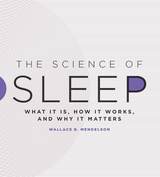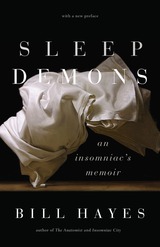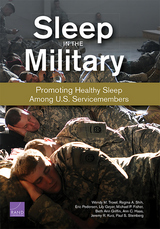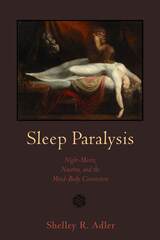4 books about Sleep disorders

The Science of Sleep
What It Is, How It Works, and Why It Matters
Wallace B. Mendelson
University of Chicago Press, 2017
We often hear that humans spend one third of their lives sleeping—and most of us would up that fraction if we could. Whether we’re curling up for a brief lunchtime catnap, catching a doze on a sunny afternoon, or clocking our solid eight hours at night, sleeping is normally a reliable way to rest our heads and recharge our minds. And our bodies demand it: without sufficient sleep, we experience changes in mood, memory loss, and difficulty concentrating. Symptoms of sleep deprivation can be severe, and we know that sleep is essential for restoring and rejuvenating muscles, tissue, and energy. And yet, although science is making remarkable inroads into the workings and functions of sleep, many aspects still remain a mystery.
In The Science of Sleep, sleep expert Wallace B. Mendelson explains the elements of human sleep states and explores the variety of sleep disorders afflicting thousands of people worldwide. Mendelson lays out the various treatments that are available today and provides a helpful guide for one of life’s most important activities. By offering the first scientific yet accessible account of sleep science, Mendelson allows readers to assess their personal relationships with sleep and craft their own individual approaches to a comfortable and effective night’s rest.
Addressing one of the major public health issues of the day with cutting-edge research and empathetic understanding, The Science of Sleep is the definitive illustrated reference guide to sleep science.
In The Science of Sleep, sleep expert Wallace B. Mendelson explains the elements of human sleep states and explores the variety of sleep disorders afflicting thousands of people worldwide. Mendelson lays out the various treatments that are available today and provides a helpful guide for one of life’s most important activities. By offering the first scientific yet accessible account of sleep science, Mendelson allows readers to assess their personal relationships with sleep and craft their own individual approaches to a comfortable and effective night’s rest.
Addressing one of the major public health issues of the day with cutting-edge research and empathetic understanding, The Science of Sleep is the definitive illustrated reference guide to sleep science.
[more]

Sleep Demons
An Insomniac’s Memoir
Bill Hayes
University of Chicago Press, 2018
We often think of sleep as mere stasis, a pause button we press at the end of each day. Yet sleep is full of untold mysteries—eluding us when we seek it too fervently, throwing us into surreal dream worlds when we don’t, sometimes even possessing our bodies so that they walk and talk without our conscious volition. Delving into the mysteries of his own sleep patterns, Bill Hayes marvels, “I have come to see that sleep itself tells a story.”
An acclaimed journalist and memoirist—and partner of the late neurologist Oliver Sacks—Hayes has been plagued by insomnia his entire life. The science and mythology of sleep and sleeplessness form the backbone to Hayes’s narrative of his personal battles with sleep and how they colored his waking life, as he threads stories of fugitive sleep through memories of growing up in the closet, coming out to his Irish Catholic family, watching his friends fall ill during the early years of the AIDS crisis in San Francisco, and finding a lover. An erudite blend of science and personal narrative, Sleep Demons offers a poignant introduction to the topics for which Hayes has since become famous, including art, eros, city life, the history of medical science, and queer identity.
An acclaimed journalist and memoirist—and partner of the late neurologist Oliver Sacks—Hayes has been plagued by insomnia his entire life. The science and mythology of sleep and sleeplessness form the backbone to Hayes’s narrative of his personal battles with sleep and how they colored his waking life, as he threads stories of fugitive sleep through memories of growing up in the closet, coming out to his Irish Catholic family, watching his friends fall ill during the early years of the AIDS crisis in San Francisco, and finding a lover. An erudite blend of science and personal narrative, Sleep Demons offers a poignant introduction to the topics for which Hayes has since become famous, including art, eros, city life, the history of medical science, and queer identity.
[more]

Sleep in the Military
Promoting Healthy Sleep Among U.S. Servicemembers
Wendy M. Troxel
RAND Corporation, 2015
Given the unprecedented demands on the U.S. military since 2001 and the risks posed by stress and trauma, there has been growing concern about the prevalence and consequences of sleep problems. This first-ever comprehensive review of military sleep-related policies and programs, evidence-based interventions, and barriers to achieving healthy sleep offers a detailed set of actionable recommendations for improving sleep across the force.
[more]

Sleep Paralysis
Night-mares, Nocebos, and the Mind-Body Connection
Adler, Shelley R
Rutgers University Press, 2011
Sleep Paralysis explores a distinctive form of nocturnal fright: the "night-mare," or incubus. In its original meaning a night-mare was the nocturnal visit of an evil being that threatened to press the life out of its victim. Today, it is known as sleep paralysis-a state of consciousness between sleep and wakefulness, when you are unable to move or speak and may experience vivid and often frightening hallucinations. Culture, history, and biology intersect to produce this terrifying sleep phenomenon. Although a relatively common experience across cultures, it is rarely recognized or understood in the contemporary United States.
Shelley R. Adler's fifteen years of field and archival research focus on the ways in which night-mare attacks have been experienced and interpreted throughout history and across cultures and how, in a unique example of the effect of nocebo (placebo's evil twin), the combination of meaning and biology may result in sudden nocturnal death.
Shelley R. Adler's fifteen years of field and archival research focus on the ways in which night-mare attacks have been experienced and interpreted throughout history and across cultures and how, in a unique example of the effect of nocebo (placebo's evil twin), the combination of meaning and biology may result in sudden nocturnal death.
[more]
READERS
Browse our collection.
PUBLISHERS
See BiblioVault's publisher services.
STUDENT SERVICES
Files for college accessibility offices.
UChicago Accessibility Resources
home | accessibility | search | about | contact us
BiblioVault ® 2001 - 2024
The University of Chicago Press









